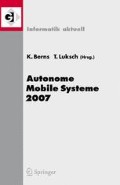Auszug
Moderne Robotersysteme werden immer komplexer und dadurch schwieriger zu entwerfen. Außerdem steigt die Wahrscheinlichkeit von Fehlern. Organic Computing versucht durch Methoden organischer Systeme wie Emergenz und Selbstorganisation gleichzeitig das Entwurfsproblem zu lösen und das autonome Reagieren auf Fehler zu erreichen, ohne den Aufwand der klassischen Fehlertoleranz zu investieren. Um auf anormale Situationen reagieren zu können, muss quasi der „Gesundheitszustand“ des Roboters erfasst werden. In diesem Beitrag wird beschrieben, wie dieser ausgehend von Sensorsignalen auf den verschiedenen Ebenen einer Steuerungshierarchie repräsentiert werden kann. Ein wesentlicher Mechanismus dazu sind „Health-Signale“. Ihre Semantik und systematische Verknüpfung werden näher erläutert und an einem einfachen Beispiel demonstriert.
Access this chapter
Tax calculation will be finalised at checkout
Purchases are for personal use only
Preview
Unable to display preview. Download preview PDF.
Literaturverzeichnis
Gat E: On Three-Layer Architectures, Artificial Intelligence and Mobile Robots, MIT/AAAI Press: 195–210, 1997
Albiez J, Luksch T, Berns K, et. al: An activation based behaviour control architecture for walking machines 7th Int. Conf. on Sim. of Adapt. Beh., MIT Press: 118–126, 2002
Brockmann W, Maehle E., Mösch F: Organic Fault-Tolerant Control Architecture for Robotic Applications. 4th IARP/IEEE-RAS/EURON Workshop on Dep. Rob. in Hum. Env., 2005
Brockmann W, Großpietsch K, Kleinlützum K, et al.: Concept for a Fault-Tolerant Control Architecture for CLAWAR Machines. 9th CLAWAR: 643–650, 2006
Brooks R, A robust layered control system for a mobile robot, IEEE Journal of Rob. and Aut. 2(1): 14–23, 1986
Brooks R.A, Intelligence Without Reason, Proc. IJCAI-91: 569–595, 1991
Lussier B, Chatila R, Ingrand F. et al.: On Fault Tolerance and Robustness in Autonomous Systems, 3rd IARP/IEEE-RAS/EURON Workshop on Dep. Rob. in Hum. Env., 2004
Ferrell C: Robust Agent Control of an Autonomous Robot with Many Sensors and Actuators. M.S. Thesis, MIT, 1993
Mösch F, Litza M, El Sayed Auf A, et al.: Organic Fault-Tolerant Controller for the Walking Robot OSCAR. Proc. of the Workshop on „Dependability and Fault Tolerance“ at ARCS, VDI, 2007
Larionova S, Jakimovski B, El Sayed Auf A, et al.: Toward a Fault Tolerant Mobile Robot: Mutual Information for Monitoring of the Robot Health Status. IARP/IEEE-RAS/EURON Workshop on Dep. Rob. in Hum. Env., 2007
Author information
Authors and Affiliations
Editor information
Editors and Affiliations
Rights and permissions
Copyright information
© 2007 Springer-Verlag Berlin Heidelberg
About this paper
Cite this paper
Kleinlützum, K., Brockmann, W., Rosemann, N. (2007). Modellierung von Anomalien in einer modularen Roboter-Steuerung. In: Berns, K., Luksch, T. (eds) Autonome Mobile Systeme 2007. Informatik aktuell. Springer, Berlin, Heidelberg. https://doi.org/10.1007/978-3-540-74764-2_14
Download citation
DOI: https://doi.org/10.1007/978-3-540-74764-2_14
Publisher Name: Springer, Berlin, Heidelberg
Print ISBN: 978-3-540-74763-5
Online ISBN: 978-3-540-74764-2
eBook Packages: Computer Science and Engineering (German Language)

